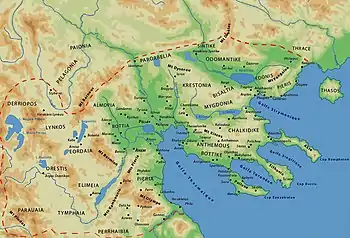Lete (Mygdonia)
Lete (Ancient Greek: Λήτη or Λητή) was an ancient city in Mygdonia, Macedon and Roman Catholic titular see in the Roman province of Macedonia.

History
Lete is known by its coins and inscriptions, mentioned in Ptolemy (III, xiii), the Pliny the Younger (IV, x, 17), Harpocration, Stephanus Byzantius and Suidas in Antiquity and in the Middle Ages in Nicephorus Bryennius (IV, xix). The spelling "Lite" is incorrect and comes from iotacism.
Marsyas of Philippi mentions it many times in book 6 of Makedonika (Ancient Greek: Μακεδονικά).[1]
In its necropolis was found the Derveni papyrus.
Lete appears in some Notitiæ episcopatuum of a late period as suffragan of the Archbishopric of Thessalonica, later united to the See of Rentina. Lete and Rentina even had Greek (Orthodox) bishops until the eighteenth century.
Lete became the small village of Aivati/Ajvatovo situated a little north of Thessaloniki. Bulgarian revolutionary Andon Dimitrov was born there in 1867.
The site of Lete is the near the modern Liti.[2]
Sources
- Harpokration, Lexicon of the Ten Orators, §l19
- Richard Talbert, ed. (2000). Barrington Atlas of the Greek and Roman World. Princeton University Press. p. 50, and directory notes accompanying.
 Herbermann, Charles, ed. (1913). "Lete". Catholic Encyclopedia. New York: Robert Appleton Company.
Herbermann, Charles, ed. (1913). "Lete". Catholic Encyclopedia. New York: Robert Appleton Company.
![]() This article incorporates text from a publication now in the public domain: Herbermann, Charles, ed. (1913). "Lete". Catholic Encyclopedia. New York: Robert Appleton Company.
This article incorporates text from a publication now in the public domain: Herbermann, Charles, ed. (1913). "Lete". Catholic Encyclopedia. New York: Robert Appleton Company.